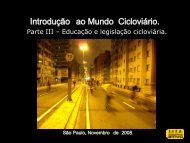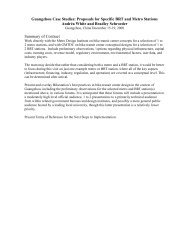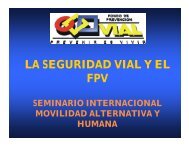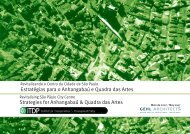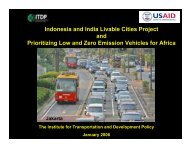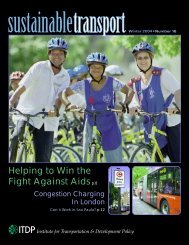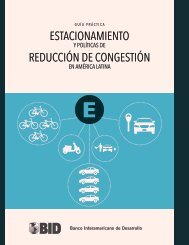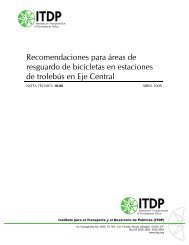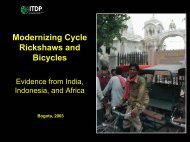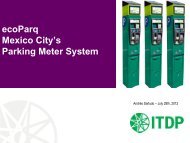Making TransJakarta a World Class BRT System - ITDP | Institute for ...
Making TransJakarta a World Class BRT System - ITDP | Institute for ...
Making TransJakarta a World Class BRT System - ITDP | Institute for ...
Create successful ePaper yourself
Turn your PDF publications into a flip-book with our unique Google optimized e-Paper software.
Lines Headway extension Travel time Boarding pax Max Volume Pax. paying<br />
BM-KT 0.4 13.01 43.58 20435 13070 85338<br />
KT-BM 0.4 13.02 43.61 16867 10070 51%<br />
KL-H 0.8 15.24 50.99 11121 6651<br />
H-KL 0.8 14.78 49.45 8450 6265<br />
P-H 0.8 12.66 42.41 10874 6548<br />
H-P 0.8 12.19 40.81 8864 5366<br />
A 0.6 22 73.97 15950 8436<br />
A 0.6 22 73.97 11034 3227<br />
D 0.5 25.98 87.34 19885 10405<br />
D 0.5 25.98 87.34 18089 10322<br />
E 0.6 16.94 56.88 12020 8331<br />
E 0.6 16.96 56.94 13897 8880<br />
TOTAL 210.8 167486<br />
As this alternative routing would more than double demand on the <strong>TransJakarta</strong> system,<br />
we suggest that this alternative routing be strongly considered. Obviously, we have not<br />
had time under the current project to determine the physical feasibility of these corridors<br />
<strong>for</strong> <strong>BRT</strong>, and the prioritization of the next corridors should be conducted using a multicriteria<br />
analysis.<br />
I.8. Fare Structure and Appropriate Ticketing <strong>System</strong><br />
I.8.a. Demand Impact of Different Fare Structures<br />
Be<strong>for</strong>e deciding on an appropriate ticketing system, an optimal fare structure needs to be<br />
decided upon. The traffic modeling results show several unequivocal results regarding<br />
the appropriate fare structure:<br />
o Distance-based fares will significantly improve <strong>TransJakarta</strong>’s Profitability<br />
o Distance-based fares are more important on Corridor I than on Corridors II and<br />
III.<br />
o Forcing passengers to pay twice to transfer between Corridor I and Corridors II<br />
and III will lead to a 25% drop in passengers on <strong>TransJakarta</strong> and big loss of<br />
revenue.<br />
Morning peak hour<br />
demand<br />
(paying<br />
pax)<br />
max<br />
frequency<br />
bus/h<br />
min. fare variable fare collected average running operating<br />
Rp. Rp./km<br />
fare USD distance km cost USD gain USD<br />
2500 0 11523 3201 13.47 2732 1973 1228 40<br />
1500 70 13653 3283 9.87 2668 1927 1356 46<br />
1000 110 16374 3719 7.94 2844 2054 1666 53<br />
1500 50 18270 4129 10.68 3491 2521 1607 62<br />
Final Recommendations <strong>for</strong> <strong>TransJakarta</strong>, p. 17



